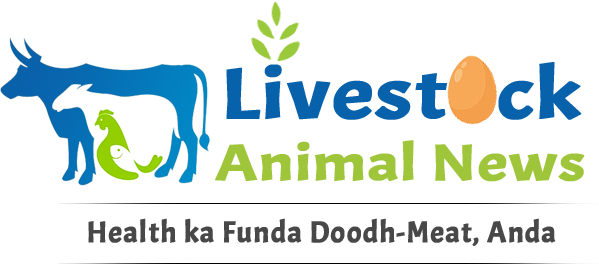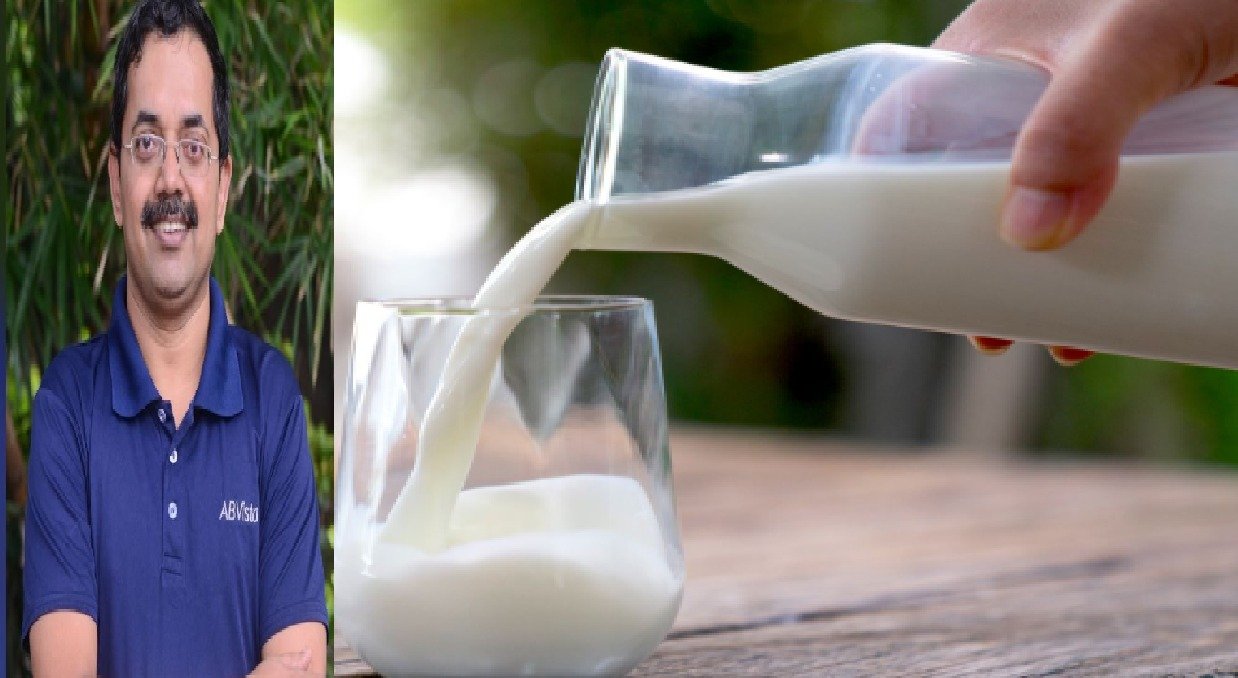NEW DELHI. As per the latest data by Animal Husbandry Ministry, India produced 230.58 MMT milk during 2022-23. The milk production has increased by 3.83% over the previous year. The average yield per animal per day for crossbred is 8.55 kg and for indigenous/nondescript cows is 3.44 kg. Top five milk producing states are Uttar Pradesh, Rajasthan, Madhya Pradesh, Gujrat and Andhra Pradesh. They together contribute 53.08% of total milk production. In total milk production, contribution of buffalo milk is 45%, cow milk is 52% and goat milk is 3%.
Workforce of 7 million engaged exclusively in the rearing of cattle and buffalo, 69 percent of them are female workers, which is 5.72 percent of the total female workforce in the country of which 93 percent live in rural areas. The milk-consuming population has been consistently rising in the country both in rural and urban areas. The liquid milk market represents about half of the total dairy market in the country. Of the total liquid milk market, the share of the organized sector has increased from 32% to 41% in the last 3 years. It is estimated that the share of the organized sector would reach 54 % by 2026. Niti Aayog estimates that the country is expected to increase its milk production to 330 million metric tonnes in 2033-34 from the current level of 230.58 million metric tonnes so that in coming years there is a possibility of India becoming the contributor of 33 percent of global milk production.
Although I did PhD in Animal Nutrition, I worked with industry and farmers very closely since 1997 and I am in regular touch with academicians as well. It’s proved by Indian poultry industry that with better genetics, we can get international level performance with better nutrition and management practices. We need to take quantum jump in next decade or so. Poultry industry became organized in India since 1972 due to availability of commercial breeds, scientific nutrition and management practices. Will this magic happen in dairy sector as well? What we expect from animal nutrition research in India in next 25 years?
In next 25 years or so, our research should focus on short term and long-term goals simultaneously. ICAR and veterinary colleges should communicate technologies to industry and farmers in local languages and in the audio-visual form. Many farmers use social media like youtube, whatsapp, facebook to learn new technologies.
Industry is the best medium to take research from lab to land. Startups have also started working in animal husbandry sector to bring new technologies to farmers. Most of these startups will need technical guidance from scientists and industry. Startups can act as R&D centers for industry. Industry and scientists should brainstorm to identify research priorities and should work jointly with policy makers and animal husbandry departments to take outcomes to farmers.
Farmers should get right price for his final produce i.e. eggs, poultry meat, milk and milk products, fish and shrimp, mutton, etc. When farmers gets price below production cost, he reduces use of compound animal feeds and switch to feed ingredients, which further reduces productivity. There will be competition from imported products. Processing of chicken should increase in India, which will help to stabilize the prices and supply. FSSAI will become stricter in selling of animal origin products. Around 33% of milk produced in India is processed by organized sector. Farmer producer companies should be promoted.
There is growing demand for A2 milk and milk products and productivity of desi cows and buffaloes can be improved by improving feeding and breeding management. Compound cattle feed should be fed as per the requirements of these cows. Farmers are not able to sustain in rearing indigenous breeds. They will need financial help from state governments. There is need of formation of breed societies and herd registration of specific breeds of livestock. For sustainable development of indigenous breeds, strengthening and empowerment of these associations will play vital role. Indigenous breeds cannot be conserved and improved without active participation of farmers.
Calf rearing is not done in scientific way in India. Feeds like milk replacer, calf starter, grower and heifer feed will help in profitable calf rearing and will help to get maximum number of lactations per animal. Transition feeds should be promoted. Still there is low awareness among farmers about use of balanced compound feeds. They use feed ingredients directly. Collaboration and coordination between state animal husbandry departments, ICAR/State veterinary Universities and industry needs to be improved for better penetration of good quality compound feeds. There is shortage of good quality manpower including vets to run animal feed sector.
During 2024, India is expected to produce around 28 MMT poultry feed, 16 MMT cattle feed and 3.5 MMT aquaculture feed. Most of the raw materials required for animal feeds are produced in India. But we may face shortages in future, as animal husbandry sector id growing fasting than crop sector.
Availability of good quality feed ingredients and their prices are major challenges for manufacturing of good quality compound feeds. Maize and SBM prices acts as benchmarks for prices of other feed ingredients. Grains and grain by products are used as source of energy and fibre in animal feeds. Government is expected to divert around 15 MMT of maize to ethanol production in next 5-6 years. Around 5 to 6 MMT of DDGS will be available as protein source for animal feeds. This will put strain on maize prices. Small amount of maize is also exported from India. Government should divert land under rice and wheat towards maize production to produce around 50 to 60 MMT, which will meet needs of feed, food, ethanol and export sectors. Government banned exports of broken rice and DORB in 2023. Millets prices are higher than maize in last few years, making it unviable to use in animal feeds. Soybean meal is main protein source in poultry feeds. In 2021, government had allowed imports of soybean meal for limited period to control prices. In future also, government may allow imports if needed. There is need to increase area and yield of not only soybeans but all other oilseeds as well. It will be win-win situation. Our edible oil imports will go down if we produce more oilseeds. We can always export surplus oilseed meals.
Lot of research took place about unconventional feed ingredients. Due to various factors like availability, price and anti-nutritional factors, their use is not more than 5% in total feed production. Although BT cotton is grown in India, there is ban on other GM crops. Therefore both farmers and feed millers are at loss. In scarcity, we should allow import GM maize and SBM. Our solvent extraction industries exports significant amount of oil meals every year. Production of animal protein is still not up to the mark as it is in hands of unorganized players. Adulteration of feed ingredients is major issue. There are not enough QC labs to test it. Use of Future trading and hedging is less. Still feed ingredients are bought and sold through traditional channels. Increase in MSP of major crops have affected prices of all feed ingredients. There is need to change crop patterns due to climatic change. So role of agriculture scientists is very important.
There is need to enhance efficiency of available feed resource use. This information would be of immense use for policy-makers, government agencies, non-government organizations, intergovernmental agencies and development agencies, among others in formulating and implementing sustainable livestock development activities and in preparing and coping with climatic variations such as droughts, floods, severe winter weather events and global climate change. There is need to integrate quality control system in feed analysis. NIR can play important role to know chemical composition of feed ingredients. Scientists and feed industries must ensure that the quality control systems and good laboratory practices are used in feed analysis laboratories.
Ruminant production is largely based on feeding of crop residues and agro-industrial by-products. However, these resources need to be properly managed. Straw is burned every year causing environmental problems and soil degradation, in addition to loss of this valuable feed resource. Crop residue management could include the use of balers for collection of straw from the field, followed by the use of processing technologies for the manufacture of balanced complete feed for ruminants. The technology for making densified total mixed ration blocks (DTMRBs) or densified total mixed ration pellets (DTMRPs) based on straw and oilseed meals is an innovative approach, which provides an opportunity for feed manufacturers and entrepreneurs to remove regional disparities in feed availability and to supply the balanced feed to dairy and other livestock farmers on a large scale. It can also be effective in disaster management and emergency situations. Other technologies, such as chopping of forages, increase animal productivity and reduce waste of forage. Substantial feed losses can be prevented by using proper postharvest technologies.
There is also need to tap new feed resources. Scientists have done studies on many unconventional raw materials but their availability and safety is more important. Some insects such as the black soldier fly, maggots (larvae of the housefly), yellow mealworm, silkworms and grasshoppers are also good sources of protein and macro-and microminerals. The protein content of insects could range from 40 to 60 per cent on a dry matter basis, with protein quality as good as muscle protein. They are also good sources of iron, zinc, vitamin A and polyunsaturated fatty acids; and have been found to be good feed ingredients for poultry and pig diets.
Area specific mineral mixtures should be fed to our animals. Deficiency of minerals such as Co, Mo, Mg, Zn, Na, Cl etc. could decrease rumen fermentation because these are vital for various activities of rumen microbes. There is growing concern among consumers about residues of antibiotics, pesticides, heavy metals, mycotoxins, etc. in final products. Feed millers use toxin binders to reduce impact of mycotoxins present in feeds.
Media is spreading negative and wrong news about livestock sector and farmers. There is only one daily newspaper in Marathi for farmers. Many startups have started apps giving lot of information and services to farmers, but how many farmers they reach is big question mark. Scientists should write more and more popular articles to educate consumers and farmers.
The aquaculture industry in India is thriving with a export demand for shrimps which is leading to growth in the shrimp feed industry. There is also an increase in the demand for fish from India both domestically and internationally which requires more effort from the aqua feed market to maintain the demand for high quality fish available in India. This is good opportunity for international and domestic aqua feed industries to establish themselves in the market.
Many animal feed additives are used in animal feed production now a days – supplied by MNCs and Indian companies. There seems to be oversupply and few customers. Commoditization has happened. Feed millers are buying only on price and credit period is prolonged. Import duties on feed additives should be reduced.
Disease challenges like bird flu – is big threat for profitable animal production in India and it impact animal feed consumption also. There is need to do more research on clinical nutrition. Prominent feed players have started building new feed mills with 10 to 40 TPH plants, but small feed millers needs to upgrade their feed milling technology. There is need to start degree courses in feed milling technology in veterinary colleges.
FSSAI directed all cattle feed millers in India to use Bureau of Indian standards (BIS) standards to control aflatoxin residues in milk and milk products. But penetration of cattle feeds is only 16%. How government will control aflatoxin coming from green and dry fodders and concenrates fed directly to cattle in India? Fodder production and yield should go up in coming years. Silage making should be promoted. Dry fodder should be available at right price throughout the year. There is need of animal feed and fodder policy to secure feed and fodder availability to our livestock. Ration balancing should be promoted among farmers. Many startups are working in this area.
India is making strides towards achieving the target of net zero carbon emissions by 2070 through many initiatives. These include areas like solar energy, Lifestyle for Environment (LiFE), green hydrogen, electric vehicles (EVs), waste-to-wealth, organic and natural farming. India is also launching a domestic compliance carbon market to facilitate trading of carbon credits. Animal husbandry sector contributes to global warming due to the emission of greenhouse gases like methane and nitrous oxide. Methane, produced through enteric fermentation and animal waste storage, has a global warming potential 28 times more than carbon dioxide. Nitrous oxide has a global warming potential 265 times more than carbon dioxide. In India, enteric fermentation accounts for 28% of the total food system emissions. India must prioritise producing more milk per unit of methane emitted. Animals should get high quality and enough feed and methane emission mitigation strategies should be implemented.
We should understand that animal diets have the same importance for animals as human diets have for humans. Animal nutrition must get due attention, especially at the policy level. Animal feeding will prove to be the foundation of efficient livestock production.
Article by Dr. Dinesh Tukaram Bhosale, Regional Commercial Director, AB Vista South Asia, Pune

















Leave a comment